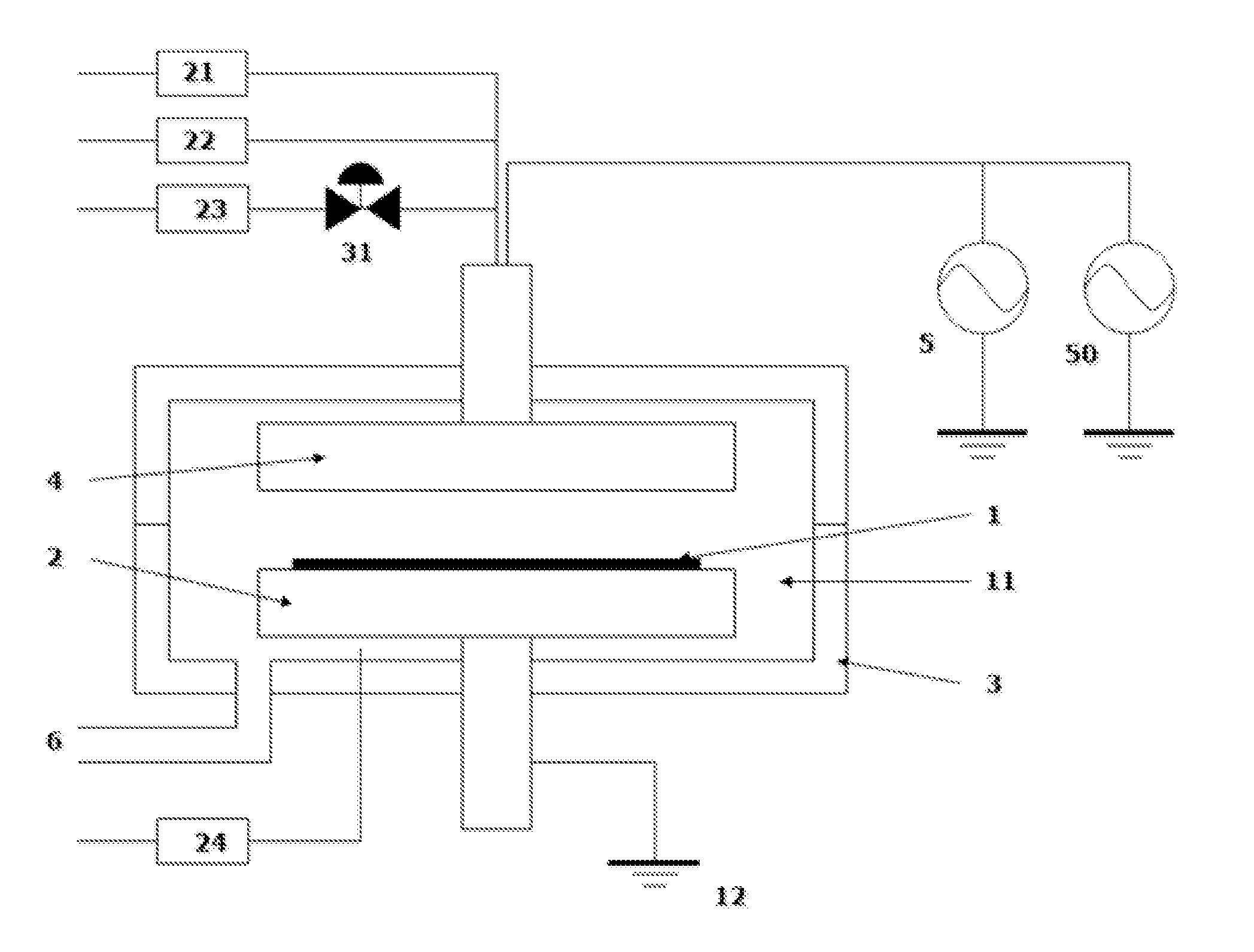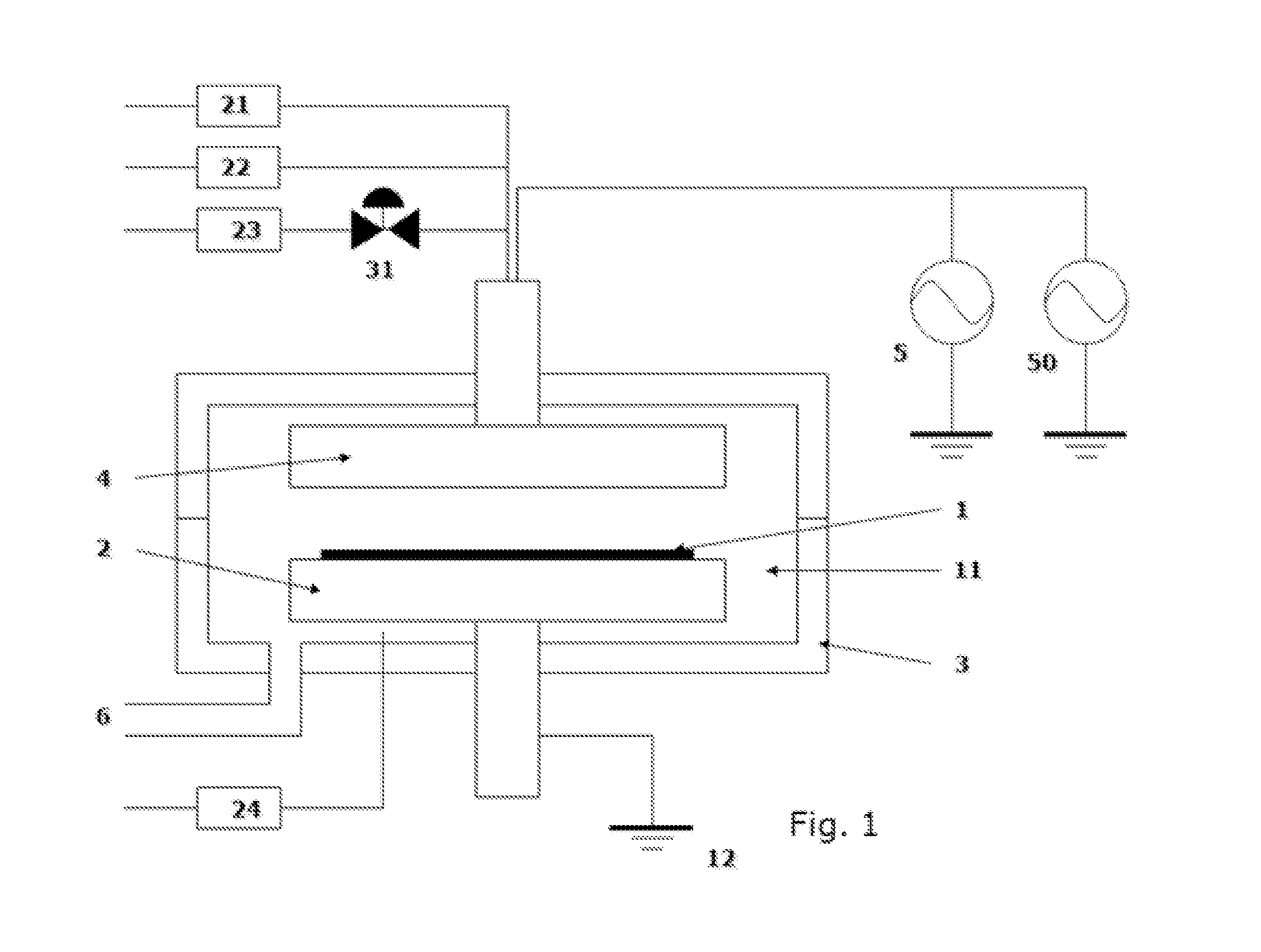Method for depositing metal-containing film using particle-reduction step
a metal-containing film and particle reduction technology, applied in the field of metal-containing film depositing method, can solve the problems of similar particle generation problem, difficult processing of process material, unavoidable particle generation, etc., and achieve the effect of reducing surface roughness, sufficient chemical resistance and mechanical strength, and simplifying process sequen
- Summary
- Abstract
- Description
- Claims
- Application Information
AI Technical Summary
Benefits of technology
Problems solved by technology
Method used
Image
Examples
examples
[0048]Metal-containing films were deposited on substrates having patterns (aspect ratio: 2:1) under common conditions shown in Table 2 or 3 below using the process sequence illustrated in FIG. 2 (continuous reactant flow) or FIG. 3 (pulsed reactant flow), and using the apparatus illustrated in FIG. 1. A precursor was fed to the reaction chamber using the flow-pass system illustrated in FIGS. 5A to 5C. For purifying gases, a Gas Clean () ST Purifier assembly (by Pall Corporation) was used, which was designed to remove contamination from many process gases, wherein sub ppb level purification was capable at designed flow rates of up to 5 slm while providing 0.003 μm filtration, and according to the technical information, it was capable of reducing impurities H2O, CO2, O2, and CO to less than 1 ppb from argon, nitrogen, and hydrogen. The purifiers were installed as illustrated in FIGS. 4A to 4C. For purifying gases, the carrier gas, dilution gas, and reactant gas passed through the puri...
examples 1 to 15
[0049]A metal oxide film was formed on a substrate (0300 mm) by PEALD under conditions shown in Table 4 below in addition to the above-described common conditions. The value (%) of O2 concentration (i.e., the partial pressure of O2) was rounded off to a natural number (no decimal place) (in some embodiments, the value is rounded off to one or two decimal places). Also, the O2 concentration when pulsed represents the concentration while being fed, not throughout the entire cycle. The growth rate per cycle (GPC) of each film was determined, and the obtained metal oxide film was evaluated in terms of the number of particles having a size of 0.1 μm or greater, and chemical resistance (wet etch rate in DHF at 100:1 as compared with thermal oxide film). The results are shown in Table 5 below.
TABLE 4O2TempConcentrationO2Ex.Precursor(° C.)(%)PurifierFlow 1*Tetrakis(dimethyl-amino)-Zr20017NoContinuous 2*Tetrakis(dimethyl-amino)-Zr20017NoContinuous 3*Tetrakis(dimethyl-amino)-Zr20017NoPulsed 4...
examples 16 to 22
[0052]A metal nitride film was formed on a substrate (0300 mm) by PEALD under conditions shown in Table 6 below in addition to the above-described common conditions. The growth rate per cycle (GPC) of each film was determined, and the obtained metal oxide film was evaluated in terms of the number of particles having a size of 0.1 μm or greater. The results are shown in Table 7 below.
TABLE 6N2 / H21)TempConcentrationN2 / H2Ex.Precursor(° C.)(%)PurifierFlow16*Tetrakis(dimethyl-amino)-Zr20017NoContinuous17*Tetrakis(dimethyl-amino)-Zr20017NoContinuous18*Tris(dimethyl-amino)-20017NoPulsedcyclopentadienyl-Zr19*Tris(dimethyl-amino)-20017NoContinuouscyclopentadienyl-Zr20Tris(dimethyl-amino)-20017YesContinuouscyclopentadienyl-Zr21Tris(dimethyl-amino)-2004NoContinuouscyclopentadienyl-Zr22Tris(dimethyl-amino)-20019YesContinuouscyclopentadienyl-Hf*denotes comparative examples.1)a flow ratio was 17% (N2 = 100 sccm; H2 = 600 sccm)
TABLE 7≧0.1 μmGPCEx.Particle(ea)(nm / cycle)16*234500.0517*252000.05518*1...
PUM
| Property | Measurement | Unit |
|---|---|---|
| temperature | aaaaa | aaaaa |
| pressure | aaaaa | aaaaa |
| size | aaaaa | aaaaa |
Abstract
Description
Claims
Application Information
 Login to View More
Login to View More - R&D
- Intellectual Property
- Life Sciences
- Materials
- Tech Scout
- Unparalleled Data Quality
- Higher Quality Content
- 60% Fewer Hallucinations
Browse by: Latest US Patents, China's latest patents, Technical Efficacy Thesaurus, Application Domain, Technology Topic, Popular Technical Reports.
© 2025 PatSnap. All rights reserved.Legal|Privacy policy|Modern Slavery Act Transparency Statement|Sitemap|About US| Contact US: help@patsnap.com



